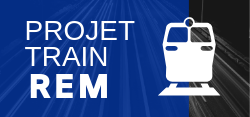Deux-Montagnes, March 20, 2018 – Mayor Denis Martin of Deux-Montagnes would like today to reiterate his support for the REM project. The REM is the largest public transit project in Quebec in the last 50 years, and its construction should begin in just a few weeks. The new electric rapid transit network will link the North Shore, Downtown Montreal, South Shore, and West Island with express service operating 20 hours a day, 7 days a week.
The REM is a concrete response to real needs that have long been expressed in the Greater Montreal Area:
- A long-term solution to multiplying the capacity of the existing rail line to Deux-Montagnes
- An efficient crossing over the Champlain Bridge, reducing traffic congestion to the downtown area (at present covered morning and evening by some 400 buses)
- Frequent service to the Montreal West Island
- Rapid service to the airport
- Integration into existing public transit networks, including three direct metro connections and numerous bus transfer points
- Universal access
As a major benefit in terms of sustainable development, the REM system will help reduce greenhouse gas emissions by roughly 35,000 CO2 equivalent tons per year, or 10,000 fewer cars on the road.
The project will generate very significant economic benefits for Montreal and Quebec:
- $4 billion in Quebec content required for its completion
- Some 34,000 jobs during construction
- 1000 permanent jobs
- A centre of excellence in automated public transit systems
- Higher productivity through greater workforce mobility
The REM will contribute significantly toward reducing the spin-off costs of traffic congestion in the metropolitan area – economic losses currently amounting to nearly $2 billion a year.
Over 70% of future REM stations will be in transit-oriented development (TOD) areas as defined in the metropolitan land use and development plan (PMAD). Which means that the REM fits perfectly into this comprehensive vision.
All development stages are now complete: environmental assessment, public consultations, financing, public tenders, detailed engineering, and selection of consortiums.
The entire process has gone forward in cooperation with Greater Montreal key players, and the REM today is ready to be built.
It’s time now to complete this great project that will benefit all residents in the greater metropolitan area.
For many years, the numerous residents of Deux-Montagnes who take the train have wanted services better adjusted to meet growing demand. The arrival of the REM is, without question, the ideal solution for meeting this demand.







